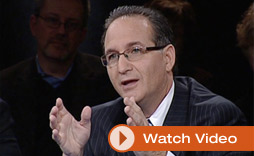
In MINDS ON THE EDGE, Judge Steven Leifman describes why people with mental illness are so easily entangled in criminal justice system.

When mental illness develops in a family member or close friend, having to deal with the police and the courts may be the last thing you would expect. But people with mental illness are very vulnerable to arrest. When they are in a delusional or psychotic state, they may exhibit "nuisance" behavior or commit a crime that brings the police to the scene. People with mental illness also have an increased risk for substance abuse and homelessness, and these factors can also make them more visible to law enforcement officers.
It can be shocking to discover a loved one with mental illness is entangled in the criminal justice system, and very difficult to help get them on a path to treatment instead of incarceration. Faced with this personal tragedy, families may not appreciate that their problems are part of a broad, nationwide trend that has been escalating for several decades.

An investigative journalist with the CBS 4 News in Miami produced this report on the Miami-Dade County jail, which Judge Leifman is working to reform.



When people with mental illness are discharged from prison, they often have trouble reconnecting with treatment providers and struggle to follow the conditions for community supervision that were required for their release. Some prisons discharge mentally ill prisoners with only a two-week supply of medication when it can take weeks to get an appointment at a community health center to continue their prescription.
Because of their period of incarceration, a person with mental illness may also have lost their job or access to essential benefit programs that had sustained them, increasing the likelihood of problems like homelessness. This often leads to a cycle of repeated arrest and incarceration that is costly to society, increasingly debilitates the person with mental illness, and is painful for families trying to provide ongoing, and much needed, support.
Once in prison or jail, people with mental illness often have difficulty obtaining their medication or other treatment. Their condition, which might be degrading due to the lack of treatment and the stress of the situation, can make it impossible for them to comply with the rigid rules in the regulated, restrictive environment of a prison. As an institution, a jail is rigidly structured to maintain safety, and prisoners with mental illness often break the rules leading to additional punishments and consequences. As the symptoms of their illness progress, their unusual behavior may make them a target for other inmates. All these factors combine to put prisoners with mental illness at a high risk for suicide while incarcerated. What begins as an arrest for petty theft, trespassing, public urination, or other minor infraction can turn into a prolonged period of incarceration, much longer than the brief sentence that would routinely be imposed on someone without a mental illness.

The cost of repeatedly arresting people with mental illness is staggering. A study of Summit County, Ohio found that in the course of one year the government spent more than $1 million on just 20 people, who were repeatedly arrested, committed to hospitals for 72 hours, jailed, or put in detoxification facilities. In Pennsylvania, a study found that inmates with mental illness cost nearly twice as much per day compared with other inmates in the prison population.
Innovations to Change a Broken System
During the past decade, many people have joined together to reverse this disturbing trend, develop innovative approaches, and try to identify solutions that work. Across the country, judges, attorneys, law enforcement officers, and corrections officials are collaborating with mental health practitioners, community leaders, and policy makers to improve outcomes for people with serious mental illnesses who have broken the law and become entangled in the criminal justice system.
There is no one solution to the problem. But many new programs have emerged that intervene and interrupt the cycle at critical points. Hundreds of cities and counties have launched major initiatives to make improvements. Others have taken the first steps, and some have yet to act. Here are three ideas to think about for your community.
- Crisis Intervention Teams (CIT) to improve police training to manage people with mental illness
- Mental Health Courts which are structured to make referrals to treatment centers instead of incarceration.
- Assertive Community Treatment (ACT) teams to provide integrated mental health and social services after release.
Learn More
Crazy: A Father's Search Through America's Mental Health Madness by Pete Earley describes his family's experience when a son with bipolar disorder is arrested. Earley, is a journalist formerly with The Washington Post, and his book also includes an investigative report on mental illness and the criminal justice system in Florida.
These organizations are working to improve the system and prevent people with mental illness from being swept up by the criminal justice system by encouraging a collaborative approach and by developing a body of knowledge about strategies that offer evidence-based solutions.
National GAINS CenterNational Center for Mental Health and Juvenile Justice
Bureau of Justice Assistance
CONTENT ACKNOWLEDGEMENT
This web content is based on information disseminated by the Council of State Governments Justice Center. To learn more about the issues, and what you can do in your community, visit http://consensusproject.org


